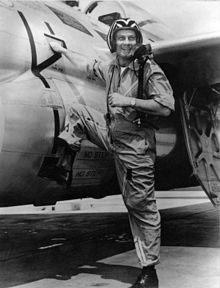Clinton D. Vincent | |
|---|---|
 Casey Vincent steps up to an F-89 Scorpion in the early 1950s. | |
| Nickname(s) | "Casey" |
| Born | November 29, 1914 Gail, Texas, US |
| Died | July 5, 1955 (aged 40) Colorado Springs, Colorado, US |
| Buried | |
| Allegiance | United States |
| Service/ | United States Army Air Corps United States Army Air Forces United States Air Force |
| Years of service | 1936–1955 |
| Rank | Brigadier General |
| Commands held | 35th Pursuit Group 68th Composite Wing 25th Air Division |
| Battles/wars | World War II |
| Awards | Army Distinguished Service Medal Silver Star Legion of Merit Distinguished Flying Cross (3) Air Medal (4) Purple Heart[1] |
Clinton Dermott "Casey" Vincent (November 29, 1914 – July 5, 1955) was an American flying ace who became the second youngest general officer in United States Army Air Forces history.[2] Vincent was one of Claire Chennault's two top fighter commanders in the China Burma India Theater of World War II. He served as the model for two comic strip characters by Milton Caniff: "Colonel Vince Casey", and "Brigadier General P.G. 'Shanty' Town".[3]
Vincent planned and carried out daring offensive air tactics in China, forming the 14th Air Force Forward Echelon which staged out of forward airfields to attack the enemy unexpectedly. The successful concept was twinned and reorganized by Chennault into two mixed-aircraft groups, with Vincent commanding one of them, the 68th Composite Wing. A string of Allied victories throughout 1943 caused the Japanese to plan a major retaliatory move. Beginning in May 1944, the airmen were hit repeatedly and forced into retreat as the Japanese implemented Operation Ichi-Go. Vincent's men demolished their valuable airbases and fell back to Chennault's stronghold at Kunming. Vincent returned to the U.S. afterward, his tour of duty complete.
Back home, Vincent was put in command of a training wing and in 1946 was asked to teach at the Air War College. Following this, he held the position of second-in-command of the Western Air Defense Force. Vincent died of a heart attack in 1955. The United States Air Force (USAF) named an air base after him in 1956: the Vincent Air Force Base in Yuma, Arizona. The airfield was turned over to the Marines in 1962, and is today the Marine Corps Air Station Yuma (Vincent Field).
- ^ Official Army Register, 1946. Page 707. "Vincent, Clinton D." (O20189) Retrieved on November 17, 2009.
- ^ USAF Biography: Brigadier General Clinton D. "Casey" Vincent Archived October 14, 2012, at the Wayback Machine. Retrieved on November 16, 2009.
- ^ Air Force Association, December 2006. The First 60 Years: The Air Force, 1947 to 2007. Archived April 15, 2010, at the Wayback Machine Retrieved on November 16, 2009.
